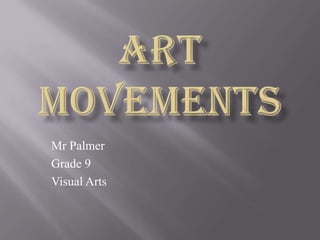
Art movements
- 1. Mr Palmer Grade 9 Visual Arts
- 2. Key Dates: 1908-1914 The Cubist art movement began in Paris around 1907. Led by Pablo Picasso and Georges Braque, the Cubists broke from centuries of tradition in their painting by rejecting the single viewpoint. Instead they used an analytical system in which three-dimensional subjects were fragmented and redefined from several different points of view simultaneously. The movement was conceived as ‘a new way of representing the world’, and assimilated outside influences, such as African art, as well as new theories on the nature of reality, such as Einstein’s Theory of Relativity. Cubism is often divided into two phases – the Analytic phase (1907-12), and the Synthetic phase (1913 through the 1920s). The initial phase attempted to show objects as the mind, not the eye, perceives them.
- 3. The Synthetic phase featured works that were composed of fewer and simpler forms, in brighter colours. Other major exponents of Cubism included Robert Delaunay, Francis Picabia, Jean Metzinger, Marcel Duchamp and Fernand Léger. Representative Artists: Georges Braque Pablo Picasso Fernand Leger Piet Mondrian Sir Jacob Epstein Juan Gris
- 4. A French 19th century art movement which marked a momentous break from tradition in European painting. The Impressionists incorporated new scientific research into the physics of colour to achieve a more exact representation of colour and tone. Impressionist art is a style in which the artist captures the image of an object as someone would see it if they just caught a glimpse of it. They paint the pictures with a lot of color and most of their pictures are outdoor scenes. Their pictures are very bright and vibrant. The artists like to capture their images without detail but with bold colors.
- 5. While the term Impressionist covers much of the art of this time, there were smaller movements within it, such as Pointillism, Art Nouveau and Fauvism. Representative Artists: Edouard Manet Eugene Boudin Frederic Bazille Alfred Sisley Edgar Degas Pierre-Auguste Renoir Mary Cassatt Camille Pissarro Claude Monet Walter Richard Sickert Berthe Morisot
- 6. Founded in Paris in 1924 by André Breton with his Manifesto of Surrealism, the movement’s principal aim was ‘to resolve the previously contradictory conditions of dream and reality into an absolute reality, a super- reality’. A literary and art movement, dedicated to expressing the imagination as revealed in dreams, free of the conscious control of reason and convention. Surrealism inherited its anti-rationalist sensibility from Dada, but was lighter in spirit than that movement. Like Dada, it was shaped by emerging theories on our perception of reality, the most obvious influence being Freud’s model of the subconscious.
- 7. The major artists of the movement were Salvador Dali, Max Ernst, René Magritte and Joan Miró. Surrealism’s impact on popular culture can still be felt today, most visibly in advertising. Representative Artists: Marcel Duchamp Georgia O’Keeffe Max Ernst Sir Henry Moore Rene Magritte Joan Miro Salvador Dali Pablo Picasso Man Ray Dorothea Tanning MC Escher
